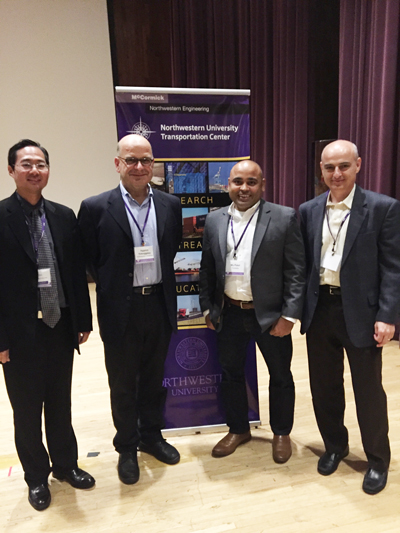Three Ways Machine Learning Will Disrupt Transportation
Experts lay out future of transportation at workshop.
According to Business Insider, 10 million self-driving cars are expected to hit the road by 2020. For many, the prospect of taking trips with unmanned vehicles may seem akin to magic, but the capability is actually the result of machine learning, a form of artificial intelligence that uses algorithms designed to learn from and respond according to the data it receives.
In the transportation industry, machine learning is the driving force behind many burgeoning technological advances. On Wednesday, October 26, industry and academic experts gathered in Northwestern’s McCormick Auditorium for “Machine Learning in Transportation,” a technical workshop hosted by the Northwestern University Transportation Center and Northwestern’s Center for the Commercialization of Innovative Transportation Technology that featured speakers from Northwestern, BMW, IBM, and more.
“Machine learning allows us to tackle tasks that are too difficult to solve with fixed programs written and designed by human beings,” said Aggelos Katsaggelos, Joseph Cummings Professor of Electrical Engineering and Computer Science at the McCormick School of Engineering. “Still, there is a give-and-take involved. We teach the machines how to learn, but analyzing how they perform informs our own learning on the subject. Transportation problems are rich in applying machine learning techniques.”
“By 2030, there will be a solution for each unique transportation purpose. Instead of commuting to work and stressing about finding parking, you can take a ride-sharing service. For more leisurely trips, self-driving cars will be able to handle transportation while you relax and watch a movie.”
—Alvin Chin, BMW Technology Corporation
1. Machine learning can be used to track congestion and save drivers time and headaches.
One area of transportation that has benefitted from machine learning is video surveillance. Katsaggelos shared a case study from his research where he developed an intelligent video surveillance system capable of recognizing traffic anomalies on its own. Using machine learning algorithms, the system can detect and track moving cars during normal traffic flow and pinpoint anomalies like congestion, accidents, or pedestrians on the road. He believes intelligent surveillance systems can save humans valuable time.
“You can’t rely on a human to analyze hours and hours of video data,” said Katsaggelos. “But an intelligent video system can look at video data of traffic and be able to identify abnormal behavior.”
2. By 2030, self-driving cars will make our commutes stress free.
Alvin Chin, senior researcher for BMW Technology Corporation, highlighted the car company’s use of machine learning to further develop connected cars. The company’s machine learning app for smartphones—BMW Connected—pulls data from BMW cars to improve the driving experience. In addition to automatically analyzing frequent routes drivers take, the app also predicts future trips and provides notifications of when to leave based off of traffic and weather conditions.

“Today, we use one vehicle for every trip purpose. If you own a car, you take it to work, to go shopping, and to go on vacation,” said Chin. “By 2030, there will be a solution for each unique transportation purpose. Instead of commuting to work and stressing about finding parking, you can take a ride-sharing service. For more leisurely trips, self-driving cars will be able to handle transportation while you relax and watch a movie.”
3. Insurance rates of the future will be based on real-time data.
Shifting the perspective to automobile insurance companies, Mo Patel, practice director, artificial intelligence and machine learning at Teradata, explained that machine learning is changing how insurers evaluate drivers. Instead of determining a consumer’s policy based off of the number of miles they have driven historically, Patel predicts machine learning technologies will allow insurance companies to establish insurance rates by using real-time data.
“Your smartphone and connected car could collect a ton of data, from location information to engine RPM cycles and accelerometer readings,” said Patel. “All of that data is allowing insurance companies to build behavior models and set rates based off of the driver. Instead of paying as you drive, you will pay how you drive.”
